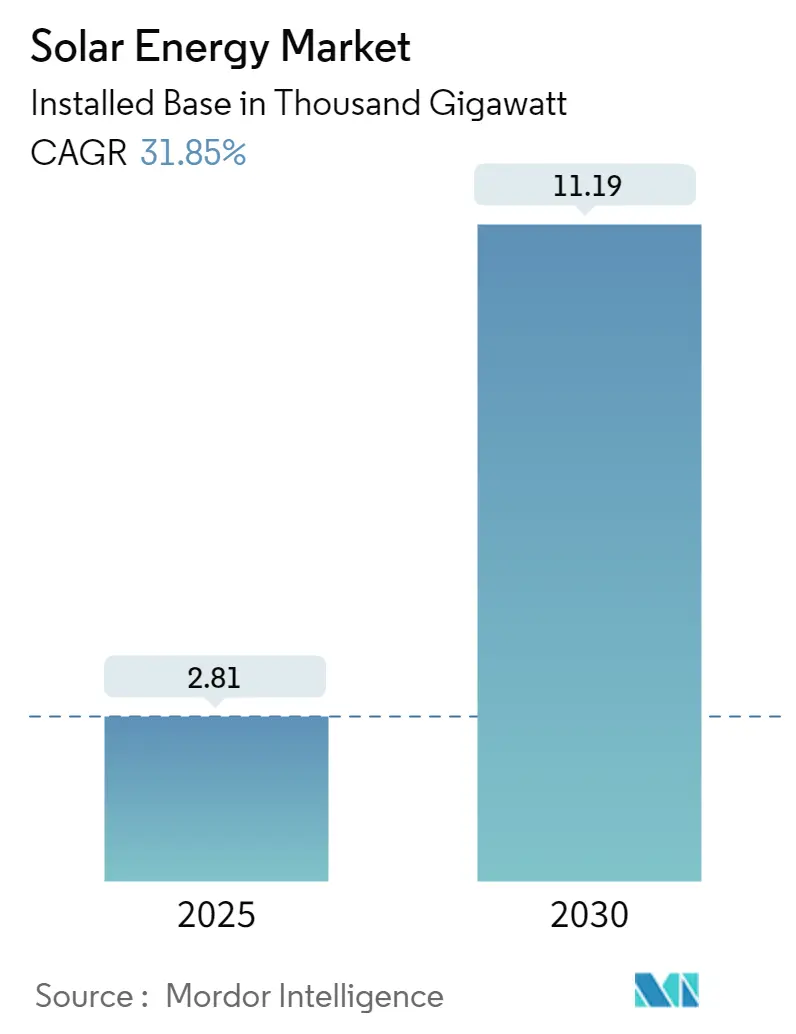
| Study Period | 2019 - 2030 |
| Market Volume (2025) | 2.81 Thousand gigawatt |
| Market Volume (2030) | 11.19 Thousand gigawatt |
| CAGR | 31.85 % |
| Fastest Growing Market | Asia-Pacific |
| Largest Market | Asia-Pacific |
| Market Concentration | Low |
Major Players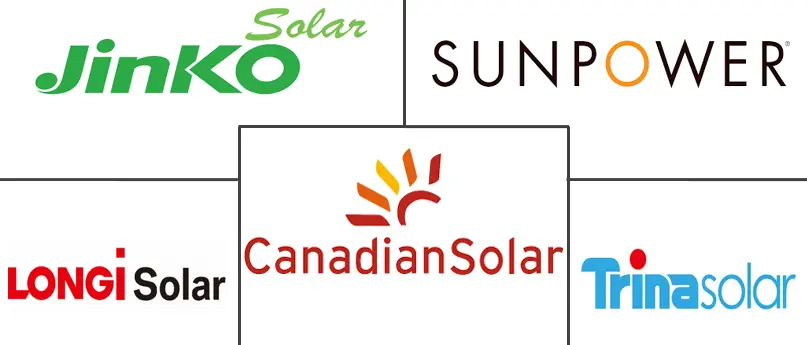
*Disclaimer: Major Players sorted in no particular order |
Solar Energy Market Analysis
The Solar Energy Market size in terms of installed base is expected to grow from 2.81 thousand gigawatt in 2025 to 11.19 thousand gigawatt by 2030, at a CAGR of 31.85% during the forecast period (2025-2030).
The solar energy industry is experiencing transformative changes driven by technological advancements and increasing efficiency improvements. The sector has witnessed remarkable cost reductions, with the levelized cost of electricity (LCOE) values in key markets like the UAE declining by 63% year-over-year in 2022, making solar power increasingly competitive with traditional energy sources. This cost reduction has been accompanied by improvements in photovoltaic (PV) technology, including the development of more efficient bifacial panels, automated robotic cleaning systems, and advanced tracking technologies that optimize solar energy generation throughout the day.
The industry has seen a significant shift towards integrated solar solutions and smart grid technologies. According to the Middle East Solar Industry Association (MESIA), commercial and industrial sectors have rapidly adopted solar power solutions, with Dubai alone recording 528 operational rooftop systems by 2023. These installations increasingly incorporate solar storage solutions, smart monitoring systems, and grid integration technologies, enabling better power management and distribution. The integration of artificial intelligence and IoT technologies has further enhanced system performance and maintenance efficiency.
The market is witnessing a strong trend towards distributed solar generation and rooftop installations across residential, commercial, and industrial sectors. A comprehensive assessment has identified over 115,000 rooftops suitable for solar installation across the UAE, Oman, Saudi Arabia, and Bahrain, demonstrating the substantial untapped potential in distributed solar energy generation. This trend is supported by the development of innovative financing models, including solar leasing arrangements and power purchase agreements (PPAs), making solar panel installations more accessible to a broader range of consumers.
The industry is experiencing a notable shift towards sustainable manufacturing practices and circular economy principles. Major manufacturers are increasingly focusing on reducing the environmental impact of solar panel production, implementing recycling programs for end-of-life panels, and developing more sustainable manufacturing processes. This transformation is accompanied by the emergence of new business models centered around solar panel recycling and refurbishment, creating additional value streams within the industry while addressing environmental concerns about waste management in the solar energy sector.
Solar Energy Market Trends
Supportive Government Initiatives
Government initiatives across Yemen, Oman, the United Arab Emirates, and Saudi Arabia have emerged as powerful catalysts for renewable energy adoption through comprehensive policy frameworks and ambitious solar energy market targets. The UAE has demonstrated a strong commitment through its Energy Strategy 2050, which aims to increase the clean energy contribution to 44% of the total energy mix by 2050. In July 2023, the UAE government updated its National Energy Strategy and announced plans to invest USD 54 billion in renewable energy over the next seven years. Additionally, these regulations mandate that new construction projects integrate renewable energy solutions into their architectural plans, while offering incentives for existing buildings to undergo retrofitting with solar power systems.
Saudi Arabia's commitment to the solar energy industry is exemplified through its National Renewable Energy Program (NREP) and Vision 2030 framework. In May 2023, the Saudi Electricity and Water Regulatory Authority (SEWRA) took a significant step by endorsing over 106 firms to spearhead small photovoltaic solar energy projects across the country. Similarly, Oman established a goal to reach net zero emissions by 2050, with interim targets for solar power market development outlined in its seven-year plan spanning 2023 to 2029. The plan aims for an 11% share of renewables in the electricity mix by 2025, increasing to 30% by 2030. These coordinated government efforts, coupled with streamlined regulatory frameworks and incentive programs, have created a conducive environment for solar power industry growth across the region.
Increasing Investments in Solar Energy Projects
The solar energy market has witnessed substantial investment growth, driven by both public and private sector commitments to expanding solar infrastructure and manufacturing capabilities. According to the International Energy Agency (IEA), global solar PV manufacturing capacity is expected to reach almost 1,000 GW in 2024, adequately meeting the annual demand for the Net Zero Emissions scenario by 2050. This growth is further evidenced by a remarkable 120% increase in new solar PV manufacturing projects announced from 2022 to 2023, aimed at creating national PV supply chains with over 20 GW of capacity in each region.
Recent investment activities highlight the scale of commitment to solar energy industry development. In February 2024, ACWA Power Co. finalized USD 2.3 billion in debt financing for three major solar projects in Saudi Arabia, earmarked for the Ar Raas 2, Saad 2, and Al Kahfah solar photovoltaic projects. In March 2023, Oman Power and Water Procurement Company granted solar energy projects worth USD 777 million to international investors, with the Manah 1 and 2 projects set to produce a total of 1,000 MW. Additionally, in July 2024, the Export-Import Bank of Korea pledged USD 150 million in project financing for a significant solar power project in the United Arab Emirates, marking South Korea's inaugural venture of this magnitude in the region. These investments not only demonstrate the growing confidence in solar power companies but also highlight the sector's ability to attract diverse international funding sources.
Segment Analysis: Location of Deployment
Ground-Mounted Segment in Solar Energy Market
The ground-mounted segment dominates the solar energy market in the selected countries, commanding approximately 93% of the total market share in 2024. This segment's prominence is driven by several large-scale utility projects across Saudi Arabia, the UAE, and Oman. The segment's growth is further bolstered by supportive government initiatives and increasing investments in utility-scale solar projects. For instance, in July 2024, Sharjah National Oil Corporation (SNOC), along with Emerge Limited, commenced operation of a 60 MWp ground-mounted solar PV plant. Additionally, in September 2023, Emirates Water and Electricity Company (EWEC) invited bids to develop the 1.5 GW Khazna solar power project in Abu Dhabi, demonstrating the continued expansion of ground-mounted installations. The segment's dominance is expected to continue with a projected growth rate of approximately 26% from 2024 to 2029, driven by increasing investments in large-scale solar projects and favorable government policies supporting utility-scale installations.
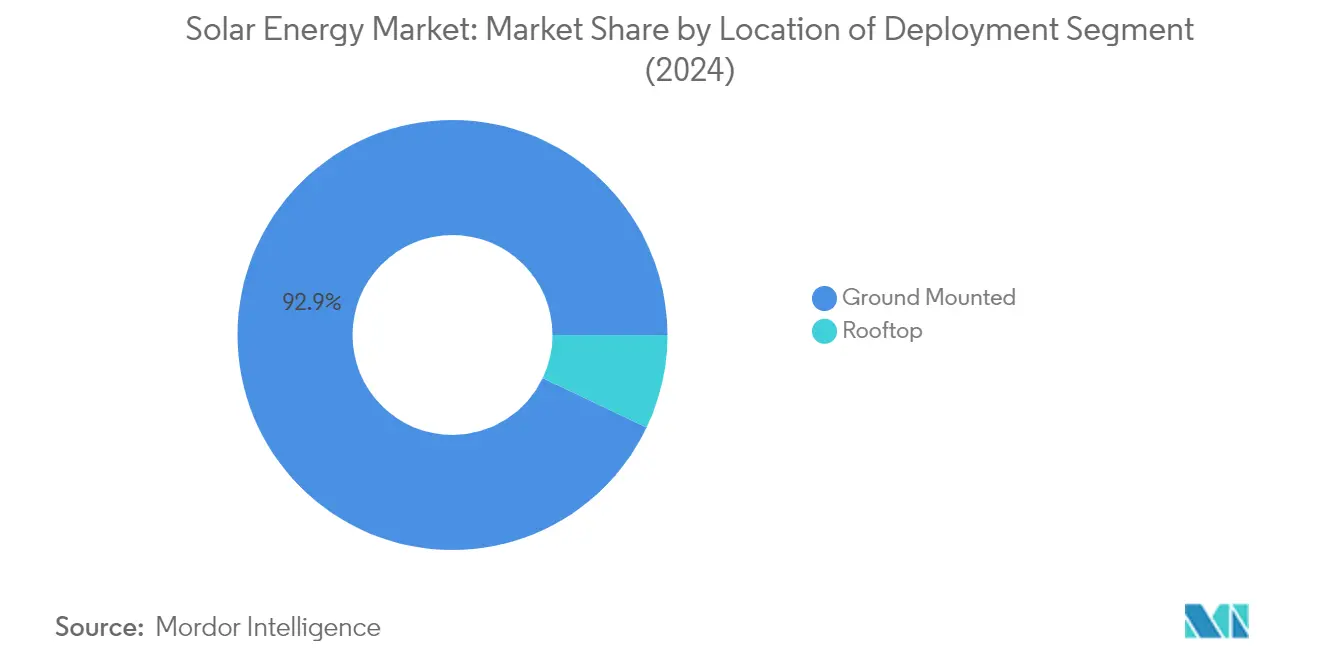
Rooftop Segment in Solar Energy Market
The solar rooftop segment represents a smaller but significant portion of the solar energy market in the selected countries. According to the Middle East Solar Industry Association (MESIA), as of 2023, Saudi Arabia led the way with cumulative commercial and residential solar rooftop system installations reaching 62,655, followed by the UAE with 46,250 and Oman with 2,478. The segment has witnessed notable developments, particularly in Dubai, which had the highest number of solar rooftop installations in the commercial and industrial sectors with 528 operational systems. For instance, in April 2024, Emerge signed an agreement to install a 980 kWp solar rooftop plant for Dubai Maritime City, while in June 2024, they also agreed to install a 3 MWp solar rooftop PV plant for AJ Steel Pipes in Abu Dhabi. These developments showcase the growing adoption of solar rooftop solutions across various sectors, particularly in commercial and industrial applications.
Segment Analysis: By End-User
Utility-Scale Segment in Solar Energy Market
The utility-scale segment dominates the solar energy market in selected countries, accounting for approximately 84% of the total installed capacity in 2024. This segment's prominence is driven by large-scale solar projects, particularly in the UAE and Saudi Arabia. The UAE's commitment to renewable energy is exemplified by projects like the Al Ajban Solar PV Independent Power Project with 1.5 GW capacity, while Saudi Arabia's ambitious National Renewable Energy Program targets significant utility-scale installations. The segment's growth is further supported by competitive auctions, bilateral utility contracts, corporate power purchase agreements (PPAs), and state-owned initiatives. Major developments include ACWA Power's finalization of USD 2.3 billion in debt financing for three solar projects in Saudi Arabia, demonstrating the robust investment landscape in utility-scale solar installations.
Commercial & Industrial Segment in Solar Energy Market
The commercial solar and industrial solar segment is experiencing the fastest growth in the solar energy market, with a projected growth rate of approximately 27% from 2024 to 2029. This rapid expansion is driven by increasing corporate sustainability initiatives and the implementation of supportive government policies across the region. In the UAE, the Shams Dubai initiative has been instrumental in promoting solar PV installations in commercial solar and industrial solar buildings, while Saudi Arabia's Vision 2030 framework encourages businesses to adopt solar energy solutions. The segment's growth is further accelerated by declining technology costs, improved financing mechanisms, and the rising awareness of environmental sustainability among businesses. Recent developments include Emerge's agreement to install a 3 MWp solar rooftop PV plant for AJ Steel Pipes in Abu Dhabi, highlighting the increasing adoption of solar solutions in the industrial sector.
Remaining Segments in End-User Market
The residential solar segment, while smaller in scale, plays a crucial role in the overall solar energy market ecosystem. This segment is characterized by solar rooftop installations and small-scale solar systems that enable households to generate their electricity. The segment's growth is supported by various government initiatives such as the Shams Dubai program in the UAE and Saudi Arabia's recent regulations for small-scale solar PV systems. The residential sector benefits from net metering policies, feed-in tariffs, and increasing consumer awareness about renewable energy benefits. Additionally, the segment is witnessing technological advancements in solar panel efficiency and solar energy storage solutions, making solar installations more attractive for homeowners.
Solar Energy Market Geography Segment Analysis
Solar Energy Market in United Arab Emirates
The United Arab Emirates stands as the dominant force in the regional solar energy market, commanding approximately 51% of the solar energy market share in 2024. The nation's leadership in solar energy is underpinned by its comprehensive UAE Energy Strategy 2050, which demonstrates a strong commitment to renewable energy adoption. The country has implemented various innovative policies and initiatives, including environment-friendly building regulations that mandate the integration of solar power solutions in new construction projects. The UAE's solar energy infrastructure is particularly notable in Dubai and Abu Dhabi, where several large-scale projects are either operational or under development. The nation's approach to solar energy development is characterized by a balanced mix of utility-scale projects and distributed solar installations, supported by programs like the Shams Dubai initiative, which encourages residential and commercial rooftop solar installations.
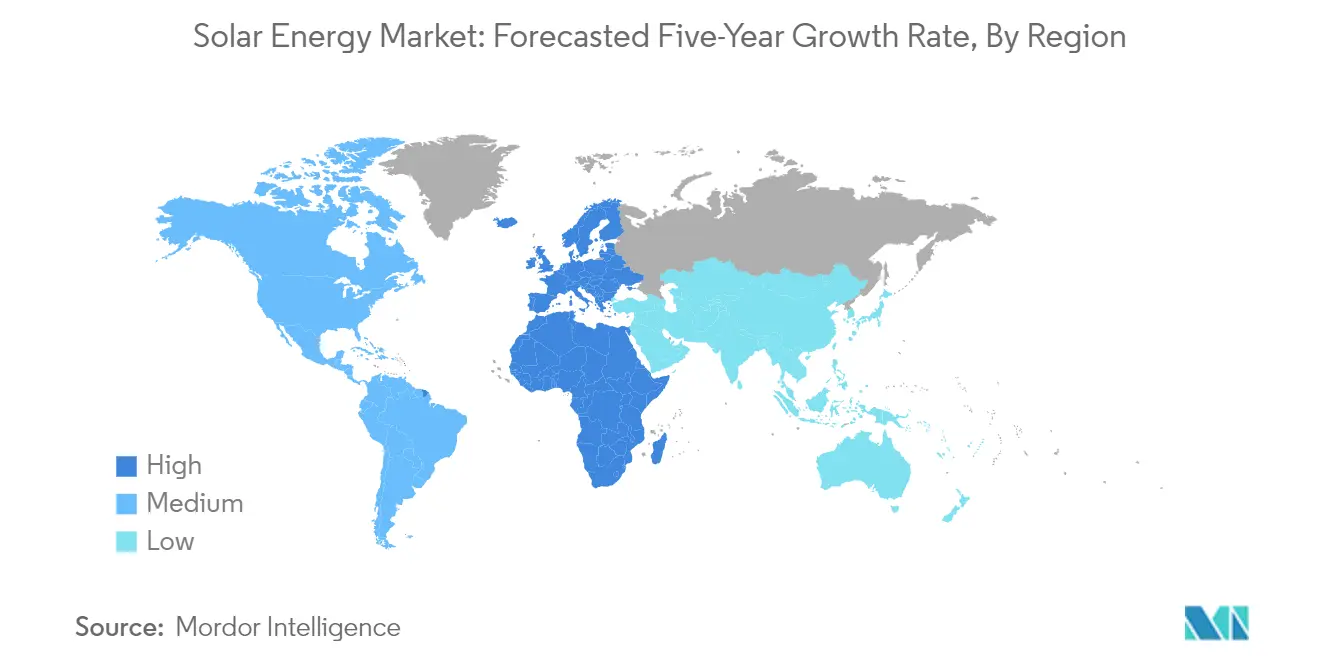
Solar Energy Market in Oman
Oman has emerged as the most dynamically growing solar energy market in the region, with a projected CAGR of approximately 39% from 2024 to 2029. The country's exceptional growth trajectory is supported by its strategic geographical advantages, receiving some of the highest solar radiation levels globally. Oman's commitment to renewable energy is exemplified through its comprehensive clean energy vision, which aims to achieve carbon neutrality by 2050. The nation has implemented several strategic initiatives, including the SAHIM program, which focuses on installing solar rooftops across the country. The government's proactive approach includes the development of both large-scale solar projects and distributed solar installations, particularly in key urban centers like Muscat, Salalah, and Duqm. The country's solar energy landscape is further enhanced by its robust regulatory framework and supportive policies that encourage both public and private sector participation in solar energy development.
Solar Energy Market in Saudi Arabia
Saudi Arabia's solar energy market demonstrates remarkable dynamism, driven by the kingdom's ambitious Vision 2030 framework and the National Renewable Energy Program. The country has established itself as a key player in the regional solar energy industry through strategic initiatives and substantial investments in solar power infrastructure. The Saudi government's commitment is evident in its comprehensive approach to solar energy development, encompassing both utility-scale projects and distributed solar installations. The nation has implemented various measures to promote solar energy adoption, including competitive auctions for large-scale projects and initiatives to encourage residential and commercial solar installations. The market's growth is further supported by the country's efforts to localize the solar energy value chain, creating opportunities for domestic manufacturing and employment while reducing dependency on imports.
Solar Energy Market in Other Countries
The solar energy landscape in other regional countries, particularly Yemen, presents unique characteristics and opportunities. These markets are characterized by varying levels of solar energy adoption, influenced by their specific geographical, economic, and regulatory environments. While some countries face challenges in infrastructure development and investment attraction, they demonstrate significant potential for solar power deployment, particularly in distributed and off-grid applications. The development of solar energy in these markets is supported by international cooperation and development initiatives, which help overcome technical and financial barriers. These countries are increasingly recognizing the importance of solar energy in achieving energy security and sustainable development goals, leading to the implementation of supportive policies and frameworks to encourage solar energy adoption across residential, commercial, and utility sectors.
Solar Energy Industry Overview
Top Companies in Solar Energy Market
The solar energy market in selected countries is characterized by intense innovation and strategic expansion activities among leading solar energy companies, including Masdar, ACWA Power, LONGi, Trina Solar, and Jinko Solar. Companies are heavily investing in research and development to improve solar cell efficiency and develop next-generation technologies, with recent breakthroughs in silicon heterojunction and perovskite cells demonstrating this commitment to innovation. Operational agility is evident through the establishment of regional manufacturing facilities and service centers, particularly in Saudi Arabia and the UAE, enabling faster responses to market demands. Strategic partnerships and joint ventures have become increasingly common, especially between international technology providers and local companies, facilitating knowledge transfer and market access. Market leaders are also focusing on expanding their project portfolios through both utility-scale installations and distributed generation solutions, while simultaneously developing integrated offerings that combine solar power with storage solutions and smart grid technologies.
Dynamic Market with Strong Regional Players
The competitive landscape is characterized by a mix of global conglomerates and regional specialists, with state-backed entities playing a particularly significant role in market development. Local champions like ACWA Power and Masdar have leveraged their government connections and regional expertise to secure major projects, while international players such as LONGi and Trina Solar have established strong footholds through strategic partnerships and local manufacturing facilities. The solar power industry shows moderate consolidation, with the top five players commanding significant market share, though numerous smaller players maintain competitive positions in specific market segments or geographical areas.
The market has witnessed substantial merger and acquisition activity, particularly focused on vertical integration and geographic expansion. Companies are increasingly pursuing strategic alliances to combine complementary capabilities, such as manufacturing expertise with local project development experience. Joint ventures between international technology providers and local companies have become a preferred mode of market entry, allowing foreign players to navigate regional regulations while providing local firms access to advanced technology and global best practices.
Innovation and Localization Drive Future Success
For incumbent solar energy players to maintain and expand their market share, a multi-faceted approach combining technological leadership, cost competitiveness, and strong local presence is essential. Success factors include continuous investment in research and development to improve panel efficiency and reduce production costs, development of integrated energy solutions incorporating storage and smart grid capabilities, and establishment of robust local supply chains and service networks. Companies must also focus on building strong relationships with government entities and utilities, given the significant role of public sector procurement in the market.
New entrants and challenger companies can gain ground by focusing on specialized market segments or innovative business models, such as distributed generation or solar-as-a-service offerings. The relatively low end-user concentration in the commercial and residential segments presents opportunities for differentiation through superior customer service and tailored solutions. While substitution risk from other renewable technologies exists, the established nature of solar technology and strong government support mitigate this threat. Regulatory frameworks are generally supportive, with policies increasingly favoring local manufacturing and content requirements, making local partnerships and manufacturing presence increasingly important for long-term success.
Solar Energy Market Leaders
-
SunPower Corporation
-
LONGi Green Energy Technology Co. Ltd
-
Trina Solar Ltd
-
Canadian Solar Inc.
-
JinkoSolar Holdings Co. Ltd
- *Disclaimer: Major Players sorted in no particular order
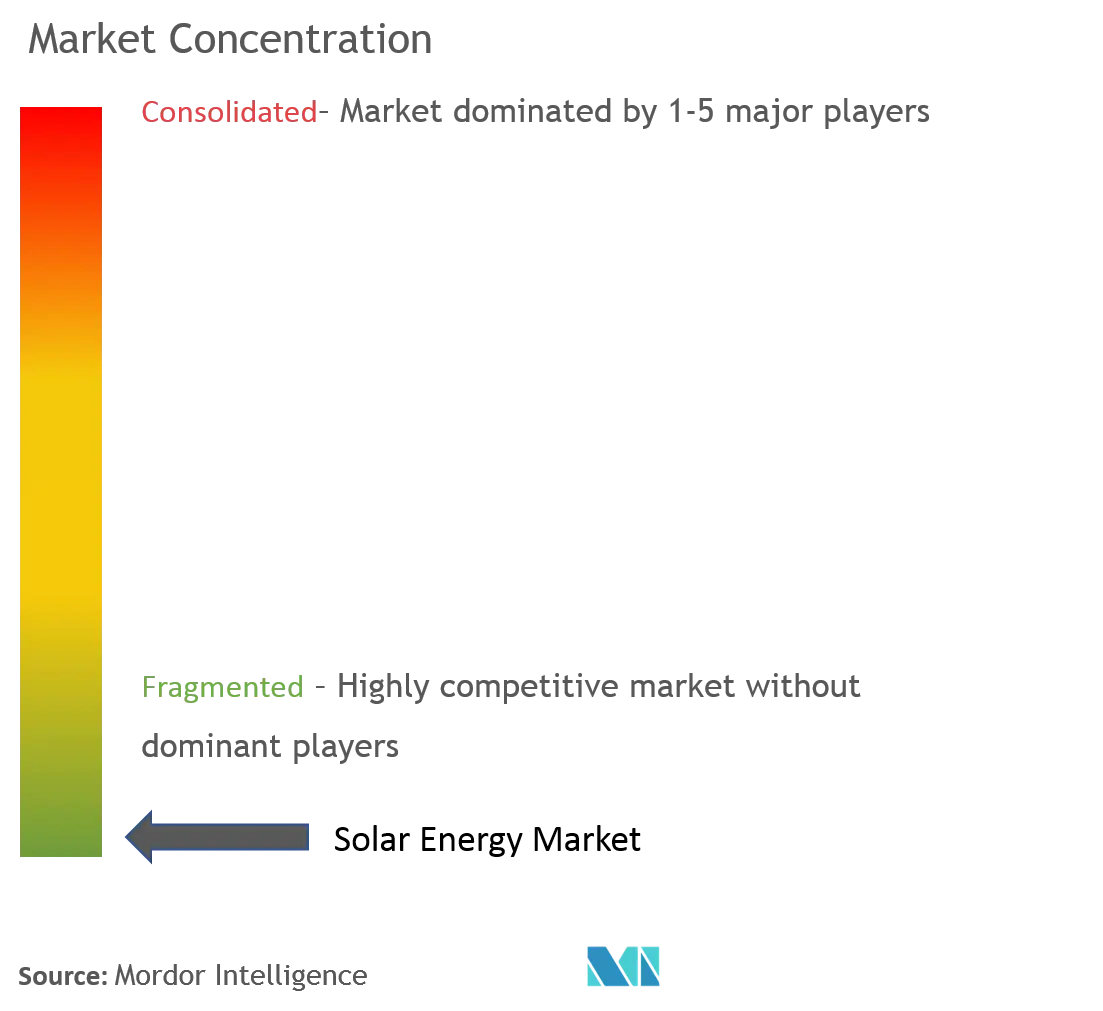
Solar Energy Market News
- February 2024: ReNew Energy Global PLC, an Indian decarbonization solutions company, collaborated with Singapore’s Sembcorp Industries Ltd to sell 350 MW of solar energy projects. The deal is estimated to be valued at around USD 241 million.
- October 2023: The Solar Energy Corporation of India (SECI) launched a tender in the Indian market to develop about 1 GW of interstate transmission grid-connected solar projects. The solar projects to be developed were likely to witness the signing off of a 25-year power purchase agreement between developers and SECI. The onset of such gigawatt-scale solar tenders and the development of projects are expected to create a spur in the solar energy market in the future.
- March 2023: BELECTRIC Solar Ltd UK and NextEnergy Solar Fund signed a framework agreement for over 150 MWp in O&M, following a competitive tendering process conducted by WiseEnergy. After signing a framework agreement for the next three years, BELECTRIC was to add an anticipated portfolio of at least ten solar farms in the United Kingdom with a total capacity of 150 MWp to its O&M footprint. The solar power plants range from 5 MW to 34 MW in capacity and are located in several counties across England, including Dorset, Lincolnshire, and East Sussex.
Solar Energy Market Report - Table of Contents
1. INTRODUCTION
- 1.1 Scope of the Study
- 1.2 Market Definition
- 1.3 Study Assumptions
2. EXECUTIVE SUMMARY
3. RESEARCH METHODOLOGY
4. MARKET OVERVIEW
- 4.1 Introduction
- 4.2 Solar Energy Installed Capacity and Forecast in GW, till 2029
- 4.3 Global Renewable Energy Mix, 2023
- 4.4 Recent Trends and Developments
- 4.5 Government Policies and Regulations
-
4.6 Market Dynamics
- 4.6.1 Drivers
- 4.6.1.1 Government Incentives and Policies
- 4.6.1.2 Declining Price and Installation Cost of Solar PV Systems
- 4.6.2 Restraints
- 4.6.2.1 Rising Adoption of Alternate Clean Power Sources
- 4.7 Supply Chain Analysis
-
4.8 Industry Attractiveness - Porter's Five Forces Analysis
- 4.8.1 Bargaining Power of Suppliers
- 4.8.2 Bargaining Power of Consumers
- 4.8.3 Threat of New Entrants
- 4.8.4 Threat of Substitute Products and Services
- 4.8.5 Intensity of Competitive Rivalry
5. MARKET SEGEMENTATION
-
5.1 Technology
- 5.1.1 Solar Photovoltaic (PV)
- 5.1.1.1 Overview
- 5.1.1.2 Solar Photovoltaic (PV) Installed Capacity and Forecast, till 2029
- 5.1.1.3 Annual Solar PV Shipments, in GW, till 2023
- 5.1.1.4 Share of Solar PV Shipments (%), by Technology, 2023
- 5.1.1.5 Average Selling Price of Solar PV Module, in USD/W, till 2023
- 5.1.1.6 Key Projects Information
- 5.1.2 Concentrated Solar Power (CSP)
- 5.1.2.1 Overview
- 5.1.2.2 Concentrated Solar Power (CSP) Installed Capacity and Forecast, till 2029
- 5.1.2.3 Solar Thermal Capacity in Operation, in GW, till 2023
- 5.1.2.4 Solar Thermal Installed Capacity Share (%), by Collector Type, 2023
- 5.1.2.5 Key Projects Information
-
5.2 Geography Regional Market Analysis {Market Size and Demand Forecast till 2028 (for regions only)}
- 5.2.1 North America
- 5.2.1.1 United States
- 5.2.1.2 Mexico
- 5.2.1.3 Canada
- 5.2.1.4 Rest of North America
- 5.2.2 Europe
- 5.2.2.1 Germany
- 5.2.2.2 Spain
- 5.2.2.3 Italy
- 5.2.2.4 United Kingdom
- 5.2.2.5 France
- 5.2.2.6 NORDIC
- 5.2.2.7 Turkey
- 5.2.2.8 Russia
- 5.2.2.9 Rest of Europe
- 5.2.3 Asia-Pacific
- 5.2.3.1 China
- 5.2.3.2 India
- 5.2.3.3 Japan
- 5.2.3.4 Australia
- 5.2.3.5 Vietnam
- 5.2.3.6 South Korea
- 5.2.3.7 Malaysia
- 5.2.3.8 Thailand
- 5.2.3.9 Indonesia
- 5.2.3.10 Rest of Asia-pacific
- 5.2.4 South America
- 5.2.4.1 Brazil
- 5.2.4.2 Argentina
- 5.2.4.3 Chile
- 5.2.4.4 Colombia
- 5.2.4.5 Rest of South America
- 5.2.5 Middle East and Africa
- 5.2.5.1 Saudi Arabia
- 5.2.5.2 United Arab Emirates
- 5.2.5.3 Egypt
- 5.2.5.4 Nigeria
- 5.2.5.5 South Africa
- 5.2.5.6 Middle East and Africa
6. COMPETITIVE LANDSCAPE
- 6.1 Mergers and Acquisitions, Joint Ventures, Collaborations, and Agreements
- 6.2 Strategies Adopted by Leading Players
-
6.3 Company Profiles
- 6.3.1 Canadian Solar Inc.
- 6.3.2 JinkoSolar Holding Co. Ltd
- 6.3.3 Trina Solar Co. Ltd
- 6.3.4 SunPower Corporation
- 6.3.5 LONGi Green Energy Technology Co. Ltd
- 6.3.6 First Solar Inc.
- 6.3.7 JA Solar Holding
- 6.3.8 Abengoa SA
- 6.3.9 Acciona SA
- 6.3.10 Brightsource Energy Inc.
- 6.3.11 Engie SA
- 6.3.12 NextEra Energy Inc.
- 6.3.13 ACWA Power
- 6.3.14 Sharp Corporation
- 6.3.15 REC Solar Holdings AS
- 6.3.16 Hanwha Corporation
- *List Not Exhaustive
- 6.4 Market Ranking Analysis
7. MARKET OPPORTUNITIES AND FUTURE TRENDS
- 7.1 Energy Storage Systems Integration
Solar Energy Industry Segmentation
Solar energy refers to the energy obtained from the Sun's radiation. It is a renewable and abundant source of energy that can be harnessed and converted into usable forms such as electricity and heat. The Sun emits electromagnetic radiation, including visible light, infrared, and ultraviolet (UV). Solar energy technologies capture and convert this radiation into usable energy for various applications.
The solar energy market is segmented by technology and geography. By technology, the market is segmented into solar photovoltaic (PV) and concentrated solar power (CSP). The report also covers the market size and forecasts for the solar energy market across major regions.
For each segment, the market sizing and forecasts are provided based on installed capacity.
Solar Energy Market Research FAQs
How big is the Solar Energy Market?
The Solar Energy Market size is expected to reach 2.81 thousand gigawatt in 2025 and grow at a CAGR of 31.85% to reach 11.19 thousand gigawatt by 2030.
What is the current Solar Energy Market size?
In 2025, the Solar Energy Market size is expected to reach 2.81 thousand gigawatt.
Who are the key players in Solar Energy Market?
SunPower Corporation, LONGi Green Energy Technology Co. Ltd, Trina Solar Ltd, Canadian Solar Inc. and JinkoSolar Holdings Co. Ltd are the major companies operating in the Solar Energy Market.
Which is the fastest growing region in Solar Energy Market?
Asia-Pacific is estimated to grow at the highest CAGR over the forecast period (2025-2030).
Which region has the biggest share in Solar Energy Market?
In 2025, the Asia-Pacific accounts for the largest market share in Solar Energy Market.
What years does this Solar Energy Market cover, and what was the market size in 2024?
In 2024, the Solar Energy Market size was estimated at 1.92 thousand gigawatt. The report covers the Solar Energy Market historical market size for years: 2019, 2020, 2021, 2022, 2023 and 2024. The report also forecasts the Solar Energy Market size for years: 2025, 2026, 2027, 2028, 2029 and 2030.
Our Best Selling Reports
Solar Energy Market Research
Mordor Intelligence provides a comprehensive analysis of the solar energy and photovoltaic industry. Our detailed research covers solar power generation, solar technology, and emerging innovations. We offer extensive coverage of the entire ecosystem, including solar panel manufacturing, solar inverter development, solar battery solutions, and solar cell technology. The report examines various segments such as residential solar, commercial solar, and industrial solar applications. It provides detailed insights into solar farm operations, solar rooftop installations, and solar installation practices. Crucial data on solar components, solar equipment, and solar mounting systems is included, available in an easy-to-read report PDF format for download.
Our research benefits stakeholders across the renewable energy industry by offering actionable insights into solar power industry growth trends and the solar energy industry outlook. The report covers essential aspects of solar thermal applications, concentrated solar power technologies, and solar tracking systems. Industry professionals gain valuable understanding of solar energy storage solutions, solar module development, and solar power generation industry dynamics. The analysis includes comprehensive coverage of solar project development strategies, solar energy services, and emerging renewable energy industry trends. This supports informed decision-making across the value chain. Our solar energy industry analysis is backed by robust research methodologies and expert consulting services, ensuring stakeholders receive the most accurate and actionable market intelligence.




